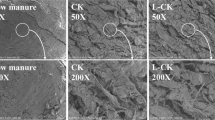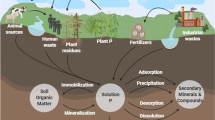Abstract
The biosorption behavior and biomineralization mechanism of low concentration uranium was investigated in this study. The results showed the obvious effects of ratio of uranium and biomass concentration, contact time, and pH value. Optimum bacterium-uranium ratio(G) is about 20–50, and the optimal pH value is about 4.0–9.0. Biosorption process can be divided into three stages: fast, slow and further biosorption stage. Numerous functional groups on the cell surface such as carboxyl, hydroxyl, amide groups, phosphoric acid group and amino group rapidly adsorbed uranyl ions. Desorption that considered as a self-protective phenomenon, was obvious in the stable adsorption. Scaly shaped uranium crystal which proved to be chernikovite uramphite (NH4)(UO2)PO4·3H2O (PDF #42-0384), was formed on cell surface with long contact time.







Similar content being viewed by others
References
Kahouli S (2011) Re-examining uranium supply and demand: new insights. Energy Policy 39(1):358–376
Jiang F, Wang Z, Chen G, Liu Y, Luo C (2021) Experimental study of pore characteristics and radon exhalation of uranium tailing solidified bodies in acidic environments. Environ Sci Pollut Res 28:20111–20120
Huang C, Zhang H, Hu N, Ding DX, Sun J (2018) Remediation of uranium contaminated groundwater by β-glycerophosphate. Zhongguo Huanjing Kexue/China Environ Sci 38(9):3391–3397
Ying WA, Zl A, Qi L, Jz A, Jl A, Jing YA, Rca C, Pl C, Jwa C (2020) Ultra-high mechanical property and multi-layer porous structure of amidoximation ethylene-acrylic acid copolymer balls for efficient and selective uranium adsorption from radioactive wastewater. Chemosphere 280:130722
Chattanathan SA, Clement TP, Kanel SR, Barnett MO, Chatakondi N (2013) Remediation of uranium-contaminated groundwater by sorption onto hydroxyapatite derived from catfish bones. Water Air Soil Pollut 224(2):1–9
Liu X, Wei F, Xu C, Liao Y, Jiang J (2015) Characteristics and classification of solid radioactive waste from the front-end of the uranium fuel cycle. Health Phys 109(3):183–186
Jlla C, Zwl B, Xglb C (2020) A metabolomic, transcriptomic profiling, and mineral nutrient metabolism study of the phytotoxicity mechanism of uranium. J Hazard Mater 386(15):121437
Gadd GM (2010) Metals, minerals and microbes: geomicrobiology and bioremediation. Microbiology 156(3):609–643
Qin H, Hu T, Zhai Y, Lu N, Aliyeva J (2019) The improved methods of heavy metals removal by biosorbents: a review. Environ Pollut 258:113777
Sánchez-Castro I, Martínez-Rodríguez P, Jroundi F, Solari PL, Merroun ML (2020) High-efficient microbial immobilization of solved U(VI) by the Stenotrophomonas strain Br 8. Water Res 183(15):116110
Wang M, Shijun WU, Yang Y, Chen F (2018) Microbial induced carbonate precipitation and its application for immobilization of heavy metals: a review. Res Environ Sci 31(2):206–214
Pabalan RT, Turner DR (1997) Uranium(6+) sorption on montmorillonite: experimental and surface complexation modeling study. Aquat Geochem 2(3):203–226
Sylwester ER, Hudson EA, Allen PG (2000) The structure of uranium (VI) sorption complexes on silica, alumina, and montmorillonite. Geochim Cosmochim Acta 64(14):2431–2438
Hagag MS, Salem F, Zaki SA, Ali AH, Esmaeel SM (2022) Uranium sorption from waste solutions by Talc Phosphogypsum ferri-silicate synthetic new sorbent. Radiochim Acta 110(2):93–106
Wang Y, Wang J, Li P, Qin H, Fan Q (2021) The adsorption of U(VI) on magnetite, ferrihydrite and goethite. Environ Technol Innov 23:101615
Smjeanin N, Nuhanovi M, Sulejmanovi J, Grahek E, Odobai A (2022) Study of uranium biosorption process in aqueous solution by red beet peel. J Radioanal Nucl Chem 331:1459–1471
Ruchhoft H (1949) Disposal of radioactive wastes by biological methods. Atomics 444:3690
Mani D, Kumar C (2014) Biotechnological advances in bioremediation of heavy metals contaminated ecosystems: an overview with special reference to phytoremediation. Int J Environ Sci Technol 11(3):843–872
Yu S, Wu X, Ye J, Li M, Liu Y (2022) Dual effect of acetic acid efficiently enhances sludge-based biochar to recover uranium from aqueous solution. Front Chem 10:3389
Sukla LB, Pradhan N, Panda S, Mishra BK (2015) [Soil Biology] environmental microbial biotechnology volume 45. Uranium Bioremed Approaches Chall 7:119–132
Xia LS, Wang M, Deng CA, Fu SF (2006) Synergistic aeration biosorption of uranium-containing wastewater by banyan leaves-activated sludge. J Nuclear Radiochem 28(4):231–235
Bai Y, Zhang J, Feng YJ (2003) Research advances in biosorption of uranium-containing wastewater. Sichuan Environ 22(2):9–14
Chen F, Tan N, Long W, Yang S, She Z, Lin Y (2014) Enhancement of uranium(VI) biosorption by chemically modified marine-derived mangrove endophytic fungus Fusarium sp. #ZZF51. J Radioanal Nuclear Chem 299(1):193–201
Psyrillou AM, Noli F (2021) Investigation of uranium biosorption using tomato peel in raw and modified form. J Radioanal Nucl Chem 330(1):305–314
Hashemi N, Dabbagh R, Noroozi M, Baradaran S (2020) Optimization of uranium biosorption in solutions by Sargassum boveanumusing RSM method. Techno-Press 9(1):65–84
Shu Y, Li S, Xie J, Guo K, Cheng C, Chen L, Peng G, Xiao F (2021) Mechanism of recombinant bacteria adsorb UO22+ under culture condition. Enzyme Microb Technol 151:109920
Hufton J, Harding J, Smith TJ, Romero-Gonzalez ME (2020) The importance of the bacterial cell wall in uranium (VI) biosorption. Phys Chem Chem Phys 23:1566–1576
Tamilselvan M, Shukla SK, Toleti SR, Kumar M (2020) Kinetic modelling of the uranium biosorption by deinococcus radiodurans biofilm. Chemosphere 269:128722
Yu Q, Yuan Y, Feng L, Sun W, Lin K, Zhang J, Zhang Y, Wang H, Wan N, Qin P (2022) Highly efficient immobilization of environmental uranium contamination with Pseudomonas stutzeri by biosorption, biomineralization, and bioreduction. J Hazard Mater 424:127758
Coelho E, Reis TA, Cotrim M, Rizzutto M, Corrêa B (2020) Bioremediation of water contaminated with uranium using Penicillium piscarium. Biotechnol Progress 6:e30322
Kilislioglu B (2003) Thermodynamic and kinetic investigations of uranium adsorption on amberlite IR-118H resin. Appl Radiat Isot 58(2):155–160
Kumar S, Dumpala R, Chandane A, Bahadur J (2022) Elucidation of the sorbent role in sorption thermodynamics of uranium(VI) on goethite. Environ Sci Process Impacts 24:567–575
Chen F, Lv M, Ye Y, Miao S, Tang X, Liu Y, Liang B, Qin Z, Chen Y, He Z (2022) Insights on uranium removal by ion exchange columns: the deactivation mechanisms, and an overlooked biological pathway. Chem Eng J 434(15):134708
Jisu L, Jung LS, Sungho K, Jong-Un L, Kwang-Soon S, Hor-Gil H (2021) Layers of uranium phosphate nanorods and nanoplates encrusted on fungus Cladosporium sp. strain F1 hyphae. Microbes Environ 36(4):34776461
Wang T, Zheng X, Wang X, Lu X, Shen Y (2017) Different biosorption mechanisms of Uranium(VI) by live and heat-killed Saccharomyces cerevisiae under environmentally relevant conditions. J Environ Radioact 167:92–99
Wang X, Wang T, Zheng X, Shen Y, Lu X (2017) Isotherms, thermodynamic and mechanism studies of removal of low concentration uranium (VI) by Aspergillus niger. Water Sci Technol 75(12):2727–2736
Zheng X, Hu P, Yao R, Cheng J, Chang Y, Wu H, Mei H, Sun S, Chen Q, Liu F (2022) Enhancement of uranium(VI) biomineralization by Saccharomyces cerevisiae through addition of inorganic phosphorus. Science 331:2217–2226
Shen Y, Zheng X, Wang X, Wang T (2018) The biomineralization process of uranium(VI) by Saccharomyces cerevisiae—transformation from amorphous U(VI) to crystalline chernikovite. Appl Microbiol Biotechnol 102:4217–4229
Merroun ML, Raff J, Rossberg A, Hennig C, Reich T, Selenska-Pobell S (2005) Complexation of uranium by cells and S-layer sheets of Bacillus sphaericus JG-A12. Appl Environ Microbiol 71(9):5532–5543
Macaskie L, Empson R, Cheetham A, Grey C, Skarnulis A (1992) Uranium bioaccumulation by a Citrobacter sp. as a result of enzymically mediated growth of polycrystalline HUO2PO4. Science 257(5071):782–784
Macaskie LE (2010) An immobilized cell bioprocess for the removal of heavy metals from aqueous flows. J Chem Technol Biotechnol Biotechnol 49(4):357–379
Fernando M, González-MuOz M, Thomas R, Romero-González M, Arias JM, Merroun ML, Jaak JP (2014) Biosorption and biomineralization of U(VI) by the marine bacterium idiomarina loihiensis MAH1: effect of background electrolyte and pH. PLoS ONE 9(3):91305
Liang X, Csetenyi L, Ga Dd GM (2016) Uranium bioprecipitation mediated by yeasts utilizing organic phosphorus substrates. Appl Microbiol Biotechnol 100(11):5141–5151
Yong P, Macaskie LE (2010) Enhancement of uranium bioaccumulation by a Citrobacter sp. via enzymically-mediated growth of polycrystalline NH4UO2PO4. J Chem Technol Biotechnol 63(2):101–108
Acharya C (2015) Uranium bioremediation: approaches and challenges. Springer Int Publ 45:119–132
Shen Y, Zheng X, Wang XT (2018) The biomineralization process of uranium(VI) by Saccharomyces cerevisiae-transformation from amorphous U(VI) to crystalline chernikovite. Appl Microbiol Biotechnol 102(9):4217–4229
Lu X, Zhou XJ, Wang TS (2013) Mechanism of uranium(VI) uptake by Saccharomyces cerevisiae under environmentally relevant conditions: batch, HRTEM, and FTIR studies. J Hazard Mater 262(15):297–303
Zheng XY, Lu X, Wang XY, Shen YH, Wang TS (2017) Biosorption and biomineralization of uranium(VI) by Saccharomyces cerevisiae-Crystal formation of chernikovite. Chemosphere Environ Toxicol Risk Assess 175:161–169
R. Livens JCRJRLb (2007) Microbial interactions with actinides and long-lived fission products. C R Chim 10(10–11):1067–1077
Acknowledgements
This research was funded by the Natural Science Foundation of Henan Province (Grant No. 202300410281), National Scientific Research Project Cultivation Fund of Huanghuai University (No. XKPY-202006), China Postdoctoral Science Foundation (Grant No.2021M700685), The Key Scientific Research Projects of Colleges and Universities in Henan Province (Grant 22A510016), Henan Provincial Science and Technology Research Project (222102310286).
Author information
Authors and Affiliations
Corresponding author
Additional information
Publisher's Note
Springer Nature remains neutral with regard to jurisdictional claims in published maps and institutional affiliations.
Supplementary Information
Below is the link to the electronic supplementary material.
Rights and permissions
Springer Nature or its licensor holds exclusive rights to this article under a publishing agreement with the author(s) or other rightsholder(s); author self-archiving of the accepted manuscript version of this article is solely governed by the terms of such publishing agreement and applicable law.
About this article
Cite this article
Zheng, X., Hu, P., Yao, R. et al. Biosorption behavior and biomineralization mechanism of low concentration uranium (VI) by pseudomonas fluorescens. J Radioanal Nucl Chem 331, 4675–4684 (2022). https://doi.org/10.1007/s10967-022-08551-3
Received:
Accepted:
Published:
Issue Date:
DOI: https://doi.org/10.1007/s10967-022-08551-3




